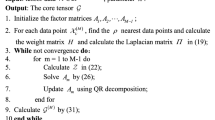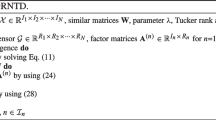Abstract
Dimensionality Reduction (DR) is a significant subject which have aroused extensive attention of researchers. In this paper, a novel method is proposed to reduce the dimensionality of tensor data based on orthogonal Tucker decomposition model and local discrimination difference regularization (OTDLDD-TDR). The proposed method not only defines the relation between high-dimensional and low-dimensional data spaces from the global view point, but also well preserves both geometric distribution (internal attribute) and tag information (external attribute) belonging to data from the local perspective. For the purpose of modeling the combination of these two types of information, we decompose the tensor data into individual parts on the basis of data distribution in sample space. Then, we calculate the local discrimination difference with regard to each part via the categories assigned in specific application scenarios. We seek to minimize the output of local discrimination difference, and impose it as a regularization constraint on the orthogonal Tucker decomposition model to finally achieve DR for tensor. The proposed method is the first attempt to organically combine tensor Tucker decomposition and local discrimination difference. We conducted comparison experiments for the proposed method, state-of-the-art methods published in recent years, and classic and representative methods. The experimental results in data classification and clustering on eight real-world datasets demonstrate the effectiveness of OTDLDD-TDR.


















Similar content being viewed by others
References
Wang W, Wang R, Huang Z, Shan S, Chen X (2018) Discriminant analysis on riemannian manifold of gaussian distributions for face recognition with image sets. IEEE Trans Image Process 27(1):151–163. https://doi.org/10.1109/TIP.2017.2746993
Skogen K, Schulz A, Helseth E, Ganeshan B, Dormagen JB, Server AJAR (2019) . Texture Analysis on Diffusion Tensor Imaging: Discriminating Glioblastoma from Single Brain Metastasis 60(3):356–366
Chen K-X, Wu X-JJCVM (2018) . Component SPD Matrices: A Low-dimensional Discriminative Data Descriptor for Image Set Classification 4(3):245–252
Han J, Cheng G, Li Z, Zhang D (2018) A unified metric Learning-Based framework for Co-Saliency detection. IEEE Transactions on Circuits and Systems for Video Technology 28(10):2473–2483. https://doi.org/10.1109/TCSVT.2017.2706264
Jolliffe I (2005) Principal component analysis. In: Encyclopedia of statistics in behavioral science. https://doi.org/10.1002/0470013192.bsa501
Li C, Wang BJCNU (2014) Fisher linear discriminant analysis
Balasubramanian M, Schwartz EL, Tenenbaum JB, de Silva V, Langford JCJS (2002) . The Isomap Algorithm and Topological Stability 295(5552):7–7
Zhang Z, Zha H (2003) Nonlinear dimension reduction via local tangent space alignment. In: International conference on intelligent data engineering and automated learning, Springer, pp 477–481
He X, Niyogi PJAinips (2004) . Locality Preserving Projections 16(16):153–160
Belkin M, Niyogi PJNc (2003) . Laplacian Eigenmaps for Dimensionality Reduction and Data Representation 15(6):1373–1396
Roweis ST, LKJs Saul (2000) . Nonlinear Dimensionality Reduction by Locally Linear Embedding 290(5500):2323–2326
Hoffmann HJPr (2007) . Kernel PCA for Novelty Detection 40(3):863–874
Wang G, Shi N, Shu Y, Liu DJNpl (2016) . Embedded Manifold-based Kernel Fisher Discriminant Analysis for Face Recognition 43(1):1–16
Zhang S, Ma Z, Gan WJIToIP (2020) . Dimensionality Reduction for Tensor Data Based on Local Decision Margin Maximization 30:234–248
Hong D, Kolda TG, Duersch JAJSR (2020) . Generalized Canonical Polyadic Tensor Decomposition 62(1):133–163
Sidiropoulos ND, Lathauwer LD, Fu X, Huang K, Papalexakis EE, Faloutsos C (2017) Tensor decomposition for signal processing and machine learning. IEEE Trans Signal Process 65(13):3551–3582. https://doi.org/10.1109/TSP.2017.2690524
Oseledets IVJSJoSC (2011) . Tensor-train decomposition 33(5):2295–2317
Bergqvist G, Larsson EG (2010) The Higher-Order singular value decomposition: theory and an application [Lecture notes]. IEEE Signal Proc Mag 27(3):151–154. https://doi.org/10.1109/MSP.2010.936030
Hao N, Horesh L, Kilmer M (2014) Nonnegative tensor decomposition. In: Compressed sensing & sparse filtering, Springer, pp 123–148
Wang C, Li Z, Sarpong B (2021) Multimodal adaptive identity-recognition algorithm fused with gait perception. Big Data Mining and Analytics 4(4):223–232. https://doi.org/10.26599/BDMA.2021.9020006
Kung H, Tu Y, Hsu C (2015) Dual subspace nonnegative graph embedding for Identity-Independent expression recognition. IEEE Trans Inform Forensics Secur 10(3):626–639. https://doi.org/10.1109/TIFS.2015.2390138
Kolda TG (2006) Multilinear operators for higher-order decompositions. Citeseer
Cai D, He X, Han J, Huang TS (2011) Graph regularized nonnegative matrix factorization for data representation. IEEE Trans Pattern Anal Mach Intell 33(8):1548–1560. https://doi.org/10.1109/TPAMI.2010.231
Zhang Z, Zhao K (2013) Low-Rank Matrix approximation with manifold regularization. IEEE Trans Pattern Anal Mach Intell 35(7):1717–1729. https://doi.org/10.1109/TPAMI.2012.274
Lu H, Plataniotis KN, Venetsanopoulos AN (2008) MPCA: Multilinear principal component analysis of tensor objects. IEEE Trans Neural Netw 19(1):18–39. https://doi.org/10.1109/TNN.2007.901277
Huang J, Su K, El-Den J, Hu T, Li J (2014) An MPCA/LDA based dimensionality reduction algorithm for face recognition. Math Probl Eng 2014:1–12. https://doi.org/10.1155/2014/393265
Zhang J, Li X, Jing P, Liu J, Su Y (2018) Low-Rank Regularized heterogeneous tensor decomposition for subspace clustering. IEEE Signal Process Lett 25(3):333–337. https://doi.org/10.1109/LSP.2017.2748604
Li X, Ng MK, Cong G, Ye Y, Wu Q (2017) MR-NTD: Manifold regularization nonnegative tucker decomposition for tensor data dimension reduction and representation. IEEE Trans Neural Netw Learn Syst 28(8):1787–1800. https://doi.org/10.1109/TNNLS.2016.2545400
Sun Y, Gao J, Hong X, Mishra B, Yin B (2016) Heterogeneous tensor decomposition for clustering via manifold optimization. IEEE Trans Pattern Anal Mach Intell 38(3):476–489. https://doi.org/10.1109/TPAMI.2015.2465901
Jiang B, Ding C, Tang J, Luo B (2019) Image representation and learning with Graph-Laplacian tucker tensor decomposition. IEEE Trans Cybern 49(4):1417–1426. https://doi.org/10.1109/TCYB.2018.2802934
Yuan S, Mao X, Chen L (2017) Multilinear spatial discriminant analysis for dimensionality reduction. IEEE Trans Image Process 26(6):2669–2681. https://doi.org/10.1109/TIP.2017.2685343
Broxson BJ (2006) The kronecker product
The Olivetti & Oracle Research Laboratory Face Database of Faces. (2016)
The Yale Face Database B. (2006)
Leibe B, Schiele B (2003) Analyzing appearance and contour based methods for object categorization. In: 2003 IEEE computer society conference on computer vision and pattern recognition. 2003 Proceedings., 18-20 June 2003, pp II–409. https://doi.org/10.1109/CVPR.2003.1211497
The UMIST Face Database. (1998)
Libor Spacek’s Facial Images Databases. (2009)
Hull JJJITopa, Intelligence M (1994) . A database for handwritten text recognition research. 16(5):550–554
Sim T, Baker S, Bsat M (2003) The CMU pose, illumination, and expression database. IEEE Trans Pattern Anal Mach Intell 25(12):1615–1618. https://doi.org/10.1109/TPAMI.2003.1251154
Chen X (2011) Cai D Large scale spectral clustering with landmark-based representation. In: Twenty-fifth AAAI conference on artificial intelligence
Estévez PA, Tesmer M, Perez CA, JMJITonn Zurada (2009) . Normalized Mutual Information Feature Selection 20(2):189–201
Pereira DG, Afonso A, Medeiros FMJCiS-S (2015) Computation. Overview of Friedman’s Test and Post-hoc Analysis 44(10):2636–2653
Author information
Authors and Affiliations
Corresponding author
Additional information
Publisher’s note
Springer Nature remains neutral with regard to jurisdictional claims in published maps and institutional affiliations.
Appendix: an example of cross validation for hyperparameters selection
Appendix: an example of cross validation for hyperparameters selection
k neigbors in classification | k clusters in clustering | Clustering accuracy | Clustering NMI | Classification accuracy |
|---|---|---|---|---|
1 | 1 | 0.1 | 0.002990249 | 0.10736 |
1 | 2 | 0.100333333 | 0.00332274 | 0.106546667 |
1 | 3 | 0.102333333 | 0.005323945 | 0.106866667 |
1 | 4 | 0.196006667 | 0.119992083 | 0.107 |
1 | 5 | 0.252166667 | 0.201983018 | 0.106866667 |
1 | 6 | 0.259373333 | 0.21614893 | 0.1064 |
1 | 7 | 0.28328 | 0.249578824 | 0.108493333 |
1 | 8 | 0.304233333 | 0.277147051 | 0.106333333 |
1 | 9 | 0.350946667 | 0.329120288 | 0.106826667 |
1 | 10 | 0.405093333 | 0.358727128 | 0.107213333 |
3 | 1 | 0.1 | 0.002990249 | 0.957733333 |
3 | 2 | 0.100333333 | 0.00332274 | 0.959013333 |
3 | 3 | 0.102333333 | 0.005323945 | 0.956826667 |
3 | 4 | 0.194266667 | 0.117861855 | 0.959346667 |
3 | 5 | 0.262866667 | 0.216403903 | 0.959453333 |
3 | 6 | 0.261093333 | 0.216956456 | 0.95788 |
3 | 7 | 0.282586667 | 0.248949389 | 0.95852 |
3 | 8 | 0.30426 | 0.277166342 | 0.958853333 |
3 | 9 | 0.347293333 | 0.326006921 | 0.95732 |
3 | 10 | 0.40508 | 0.357616139 | 0.95908 |
5 | 1 | 0.1 | 0.002990249 | 0.955186667 |
5 | 2 | 0.100333333 | 0.00332274 | 0.954426667 |
5 | 3 | 0.102333333 | 0.005323945 | 0.955 |
5 | 4 | 0.194253333 | 0.117770819 | 0.954546667 |
5 | 5 | 0.25592 | 0.206837358 | 0.954466667 |
5 | 6 | 0.2665 | 0.225643294 | 0.954293333 |
5 | 7 | 0.28316 | 0.249486005 | 0.95528 |
5 | 8 | 0.304206667 | 0.277028743 | 0.953746667 |
5 | 9 | 0.34582 | 0.323015533 | 0.95588 |
5 | 10 | 0.40506 | 0.357261795 | 0.95344 |
7 | 1 | 0.1 | 0.002990249 | 0.951573333 |
7 | 2 | 0.100333333 | 0.00332274 | 0.950106667 |
7 | 3 | 0.102333333 | 0.005323945 | 0.951026667 |
7 | 4 | 0.19602 | 0.119923619 | 0.951733333 |
7 | 5 | 0.253406667 | 0.203957807 | 0.950666667 |
k neigbors in classification | k clusters in clustering | Clustering accuracy | Clustering NMI | Classification accuracy |
|---|---|---|---|---|
7 | 6 | 0.260186667 | 0.216671227 | 0.951466667 |
7 | 7 | 0.281993333 | 0.24838152 | 0.951693333 |
7 | 8 | 0.304226667 | 0.277069473 | 0.95128 |
7 | 9 | 0.350946667 | 0.328048329 | 0.951053333 |
7 | 10 | 0.4051 | 0.35790672 | 0.950866667 |
9 | 1 | 0.1 | 0.002990249 | 0.947053333 |
9 | 2 | 0.100333333 | 0.00332274 | 0.948013333 |
9 | 3 | 0.102333333 | 0.005323945 | 0.94764 |
9 | 4 | 0.196006667 | 0.119980383 | 0.946853333 |
9 | 5 | 0.258686667 | 0.210747986 | 0.948026667 |
9 | 6 | 0.260873333 | 0.217333833 | 0.946973333 |
9 | 7 | 0.283066667 | 0.248574859 | 0.947386667 |
9 | 8 | 0.304246667 | 0.277099256 | 0.946333333 |
9 | 9 | 0.34834 | 0.325486866 | 0.94812 |
9 | 10 | 0.405026667 | 0.357813192 | 0.946666667 |
11 | 1 | 0.1 | 0.002990249 | 0.944066667 |
11 | 2 | 0.100333333 | 0.00332274 | 0.943533333 |
11 | 3 | 0.102333333 | 0.005323945 | 0.945013333 |
11 | 4 | 0.196 | 0.120011443 | 0.9424 |
11 | 5 | 0.257146667 | 0.208703978 | 0.943466667 |
11 | 6 | 0.270413333 | 0.230616165 | 0.944106667 |
11 | 7 | 0.28368 | 0.249866845 | 0.94408 |
11 | 8 | 0.30422 | 0.27710678 | 0.943546667 |
11 | 9 | 0.351226667 | 0.331495983 | 0.94436 |
11 | 10 | 0.40502 | 0.35760244 | 0.944426667 |
Rights and permissions
About this article
Cite this article
Gao, W., Ma, Z. & Yuan, X. Dimensionality reduction algorithm of tensor data based on orthogonal tucker decomposition and local discrimination difference. Appl Intell 52, 14518–14540 (2022). https://doi.org/10.1007/s10489-022-03165-4
Accepted:
Published:
Issue Date:
DOI: https://doi.org/10.1007/s10489-022-03165-4




